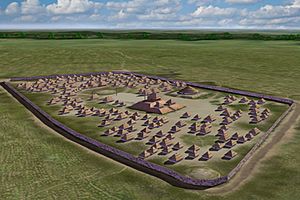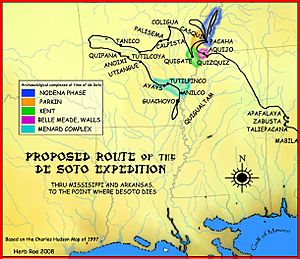Pacaha facts for kids

Pacaha was the name of a powerful Native American group and their leader. They lived in what is now northeastern Arkansas. In 1541, a Spanish explorer named Hernando de Soto and his expedition met the Pacaha people.
The Pacaha group was named after their chief, Pacaha, who was born in the early 1500s. His main village was located along the Mississippi River. Today, experts believe this village was near Turrell, Arkansas in Crittenden County, Arkansas. Archaeologists call this important place "The Bradley Site." It is part of a larger historical period known as the Nodena phase.
We know about Chief Pacaha and his people because of the journals kept by members of Hernando de Soto's expedition. De Soto and his group stayed in Pacaha's village for about 40 days.
De Soto's Journey to Pacaha

When Hernando de Soto's expedition first met the Pacaha, things were not peaceful. The Pacaha tribe had been fighting for a while with a nearby group led by a chief named Casqui. The Casqui tribe likely lived near what is now Parkin, Arkansas. This area is now Parkin Archeological State Park.
De Soto's group met the Casqui tribe first. When de Soto decided to visit the Pacaha village, many Casqui people followed him. When the Pacaha saw their enemies approaching, many tried to escape to an island in the river. Sadly, some drowned. The Casqui who came with de Soto attacked the Pacaha village. They damaged important religious sites and stole valuable items.
Peace Between Tribes
The Pacaha controlled more land and had more people than the Casqui. However, Chief Pacaha was younger than the Casqui chief. He seemed to have more to lose from the ongoing attacks by the Casqui.
De Soto contacted Chief Pacaha and explained that his expedition had nothing to do with the attack. He promised that his group had peaceful intentions. De Soto even told the Pacaha that his expedition would help them attack the Casqui to punish them.
The Casqui tribe found out about the planned attack. To avoid trouble, they returned the stolen items and apologized. De Soto then arranged a special dinner for both chiefs. At this dinner, they agreed to a peace treaty between their tribes.
Chief Pacaha gave de Soto some important people from his tribe as gifts. This was a way to show thanks for the peace agreement. It was also a way to show that he was more generous than his rival, Chief Casqui, who had only given de Soto his daughter.
What Happened Next?
The journals from Hernando de Soto's expedition are the only historical records we have of Chief Pacaha and his people. We do not know for sure what happened to them later.
In one account, the name Pacaha was spelled "Capaha." Some historians think this name might be connected to the historic Quapaw tribe. European explorers met the Quapaw in Arkansas in the 1600s and 1700s. The main village of the eastern Arkansas Quapaw was called Kappa or Kappah.
Today, human remains and cultural items found at the suspected Pacaha site are returned to the Quapaw and Tunica-Biloxi tribes. These tribes are still active today.

